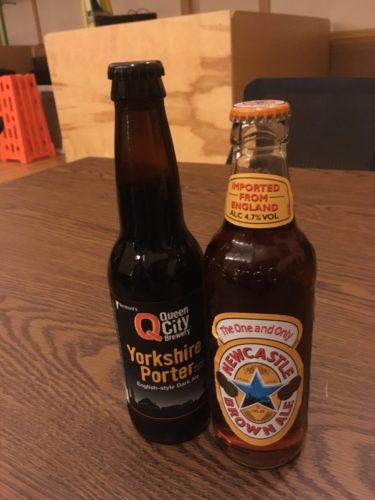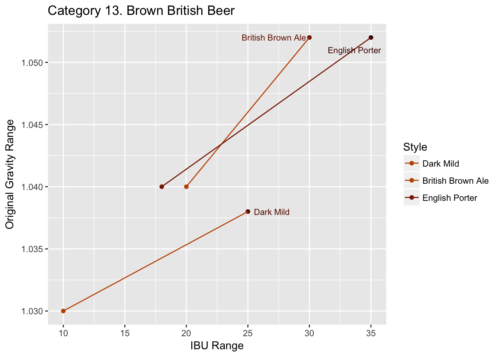BJCP Study Group: Category 13
¶ by Rob FrieselOur BJCP study group’s eleventh session convened to cover Category 13, the Brown British Beers. 1 Attendance was a little light, and we were short one style, but we made the most with what we had.
We ran the night with no guest judges, and kicked things off with very little in the way of preambles.
Category 13: Brown British Beer
The 2015 BJCP Style Guide introduces Category 13 as follows: (emphasis added)
While Dark Mild, Brown Ale, and English Porter may have long and storied histories, these guidelines describe the modern versions. They are grouped together for judging purposes only since they often have similar flavors and balance, not because of any implied common ancestry. The similar characteristics are low to moderate strength, dark color, generally malty balance, and British ancestry. These styles have no historic relationship to each other; especially, none of these styles evolved into any of the others, or was ever a component of another. The category name was never used historically to describe this grouping of beers; it is our name for the judging category. “Brown Beer” was a distinct and important historical product, and is not related to this category name.
In other words, these are brown beers, generally brewed with “characterful British ale yeast”, that have a largely malty profile. There is some bitterness for balance (and an English Porter’s may be significant), but these should lean sweet, even with finishing gravities at 1.008 — thus: sweet impression by dry mouthfeel. Some fruity esters are OK; small amounts of diacetyl are OK; generally no astringency despite the dark color.
| 13A. Dark Mild | 13B. British Brown Ale | 13C. English Porter |
|---|---|---|
| 10 – 25 IBU | 20 – 30 IBU | 18 – 35 IBU |
| 1.030 – 1.038 O.G. | 1.040 – 1.052 O.G. | 1.040 – 1.052 O.G. |
| 1.008 – 1.013 F.G. | 1.008 – 1.013 F.G. | 1.008 – 1.014 F.G. |
| 3.0 – 3.8% ABV | 4.2 – 5.4% ABV | 4.0 – 5.4% ABV |
- 13A. Dark Mild. Absent. Our leader for the night hadn’t been able to find any suitable commercial examples. As “homework”, we had a brief discussion of which breweries locally might have something like this. Simple Roots has Monarch, though that hasn’t been seen in the wild in a while. Goodwater has Proper Mild, which they appear to have available now (late-October 2017).
- 13B. British Brown Ale. Newcastle Brown Ale. Scored with structured evaluation. Scores were generally clustered just north or south of 40. Most folks called out one of two faults: 2 either they detected a metallic (“coppery”) quality, or else some oxidation in the form of a “papery” character. We had a discussion there about how caramel flavors can show up similarly to oxidation, and that it’s possible what some were perceiving as a to-style caramel quality, others perceived as oxidation. (We still haven’t come to a firm conclusion on how to tell the two apart.) The discussion of caramel flavors and malts led into a side bar about the beer’s hop character — or rather, the beer’s near lack of hop character. Style 13B not being hoppy to begin with, we discussed how those caramel flavors, which were moderately intense, could easily cover up earthy/herbal British hops, which themselves are low intensity and likely used in low quantities. We also had a quick discussion at the end about Newcastle’s use of clear bottles and whether the beer was lightstruck or not. (Most of us couldn’t perceive anything like the notorious “skunk”.)
- 13C. English Porter. Queen City Yorkshire Porter. Scored with a structured evaluation. The group broke into two clusters here, one that was in the mid-30s, the other in the low-40s. Everyone enjoyed the beer, but a couple of observations were common to those that were in the lower-scoring cluster. First, several group members observed some astringency, particularly in the finish of the beer; it was perceived as low-intensity, but was definitely perceptible. While the style guide did not explicitly say anything about astringency, the group tended to agree that such a quality would not be desirable. The other common observation among the mid-30s cluster, was the perception of alcohol coming through — this was particularly noted in the aroma (“slightly boozy”) and mouthfeel (“gently warming”). The label says 5% which is clearly in-band for the style, but as we discussed this, we concurred: this isn’t information you would have during a homebrew competition, so you would have to follow your perceptions, and in a case like that, you would probably write something like: Noticeable alcohol gives perception of a beer too-strong for style; consider lowering O.G. a couple points.
- Bonus beer. Only one bonus beer tonight. My own Otaku Supper. People generally seemed to like it, though the carbonation had noticeably off-gassed from when I filled the growler only two hours earlier. (Bummer.) Feedback speculated on some estery qualities, and whether or not it had enough body.
Takeaways
- Caramel vs. oxidation. I feel like this has come up before, but I’m not finding explicit reference to it in my notes. Regardless, as noted above, this seems to be a tricky area. I, for one, tend to perceive oxidation as a “dulling” of the flavors I’m otherwise expecting — but that’s a comparative assessment, and not a rubric one can apply to a beer being encountered for the first time. The notorious “cardboard” and “papery” descriptors aren’t ones that I typically perceive. Meanwhile, apparently caramel malts can lend flavors with similar perceptual characteristics. How to tell these apart?
- Go with your perceptions! I feel like this has come up before also, but it’s worth underscoring: in competition, you won’t have the benefit of a commercial label where you can look up ABV or IBU or packaging dates etc. All you have is the beer in your cup and your perceptual organs. Trust what you perceive and only comment on that. In other words, even if the label says “5%” but your nose detects alcohol — comment on it! (Because there’s no label in competition.)
- Though my fingers keep wanting to flip it to British Brown Beers…[↩]
- Though, interestingly, I don’t recall anyone calling out both “oxidation” and “metallic” — and I’m curious if there’s a relationship there?[↩]


Leave a Reply